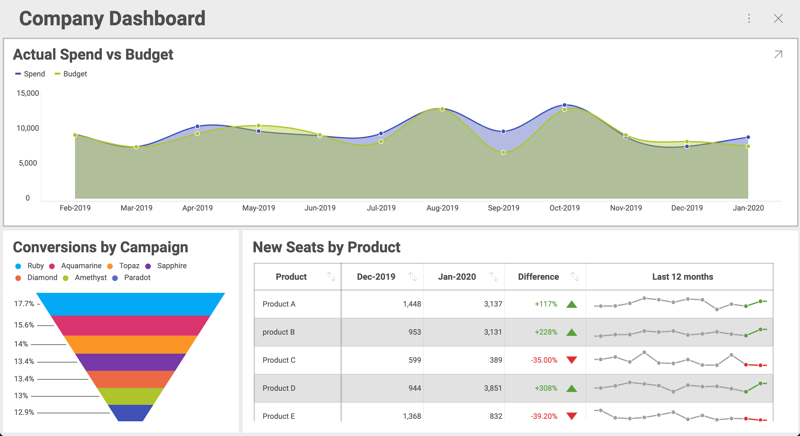Maximizing Visualizations
When displaying a dashboard to the user, there are some cases in which you’d like to display just one maximized visualization. In addition, you might also want to lock the initial visualization and prevent the user from accessing the whole dashboard. You can achieve both scenarios using the Desktop SDK.

Example Details
Let’s assume that you have a dashboard with three visualizations, where each visualization is showing data for a different division of your company, i.e., “Marketing”, “Sales” and “HR”.

In this example, you’d like to showcase these visualizations in your corporate application. You want to include them as part of the information displayed on each division’s home page.
Maximizing Visualizations
To open a dashboard with a maximized visualization, you need to use the MaximizedVisualization property of RevealView after you have assigned the revealView.Dashboard property. When you don’t set a visualization in this attribute, the whole dashboard is displayed.
You can display a specific dashboard in your page. This time, you also need to set the MaximizedVisualization attribute. As shown in the code snippet below with the visualization "Sales".
var revealView = new RevealView();
using (var fileStream = File.OpenRead(path))
{
var dashboard = new RVDashboard(fileStream);
revealView.Dashboard = dashboard;
revealView.MaximizedVisualization = dashboard.Visualizations.GetByTitle("Sales");
}
Although the initial maximized visualization will be the one with title ‘Sales’, the end user can still return to the dashboard and see the rest of the visualizations.
Single Visualization Mode
You may also want to lock the initial visualization, making it the only one displayed at all times. This way the dashboard works like a single visualization dashboard. This is the concept behind “single visualization mode”.
To turn on the “single visualization mode”, just set the SingleVisualizationMode property to true, as shown below.
revealView.SingleVisualizationMode = true;
After adding this single line, the dashboard will work as a single visualization dashboard. You can do the same for each division’s home page, just replace the title of the visualization in dashboard.Visualizations.GetByTitle() with the right one.
Dynamically changing a locked visualization
It is also possible for you to dynamically change the single visualization being displayed, without reloading the page. From the user’s perspective, your app would be a single page application with a selector of divisions and a maximized visualization. After the user chooses one division from the list, the maximized visualization is updated.
You can achieve this scenario by using the MaximizeVisualization method in RevealView or set the MaximizedVisualization property, as shown below:
private void MaximizeVisualization(string title)
{
revealView.MaximizeVisualization(revealView.Dashboard.Visualizations.GetTitle(title));
//or set the property
revealView.MaximizedVisualization = revealView.Dashboard.Visualizations.GetTitle(title);
}
Finally, you have to connect your custom control with the method above. That way the visualization will be maximized when the selection in your application changes.
To take into account:
- You can generate the list of buttons dynamically by iterating the list of visualizations in the dashboard. For further details see RVDashboard.Visualizations.
- There is a working example in the Manufacturing.xaml.cs view, in the UpMedia WPF application distributed with the SDK. That sample view shows all visualizations as a list of toggle buttons, at the bottom of the screen.